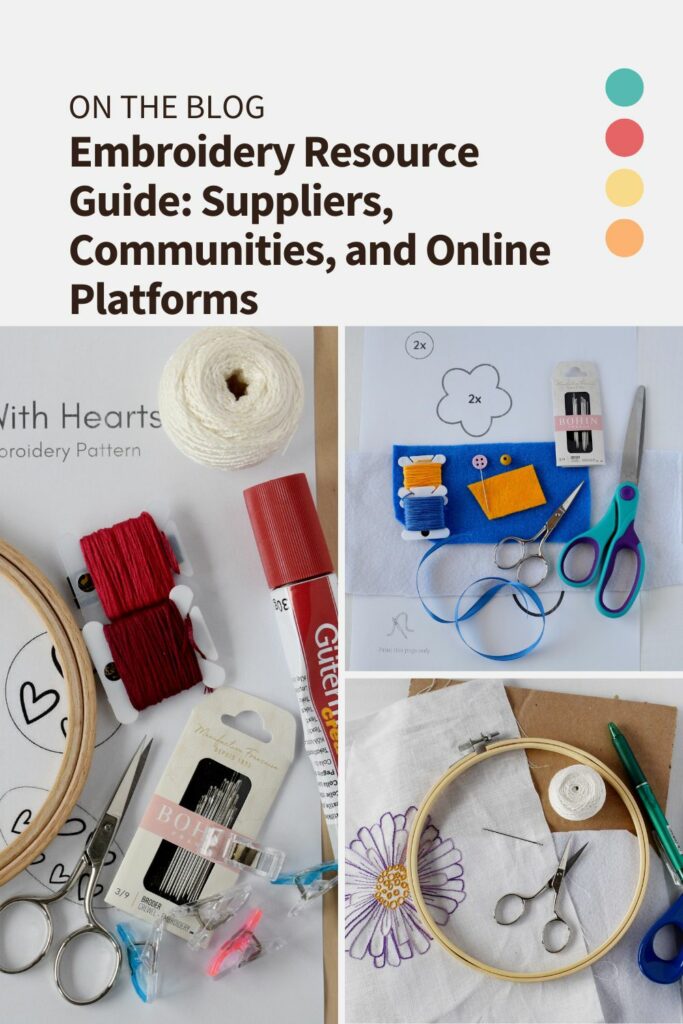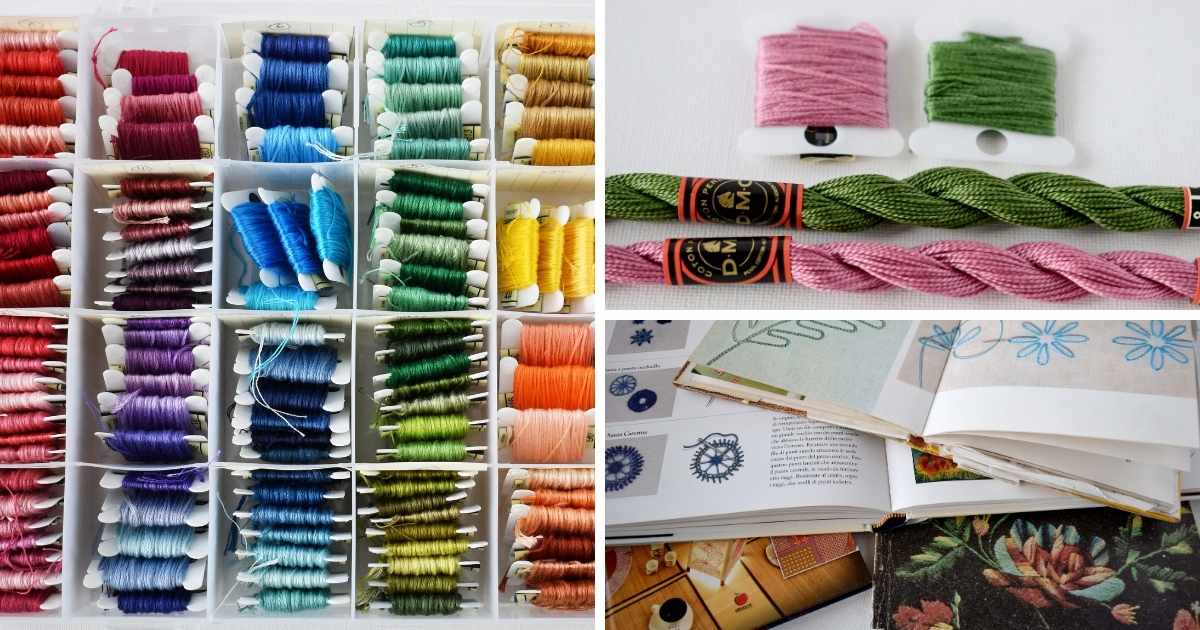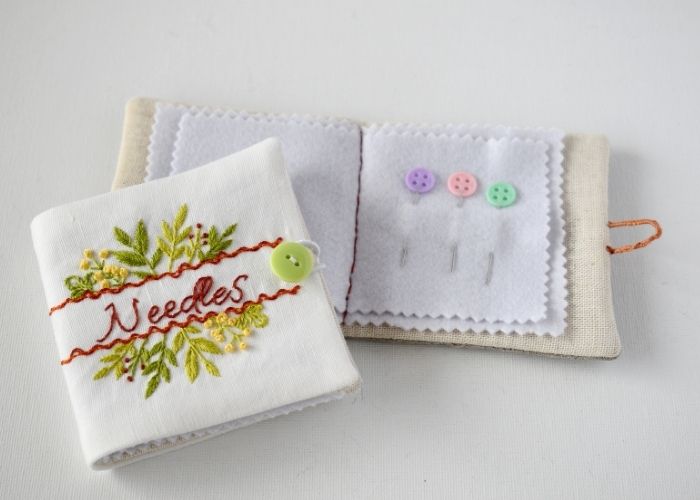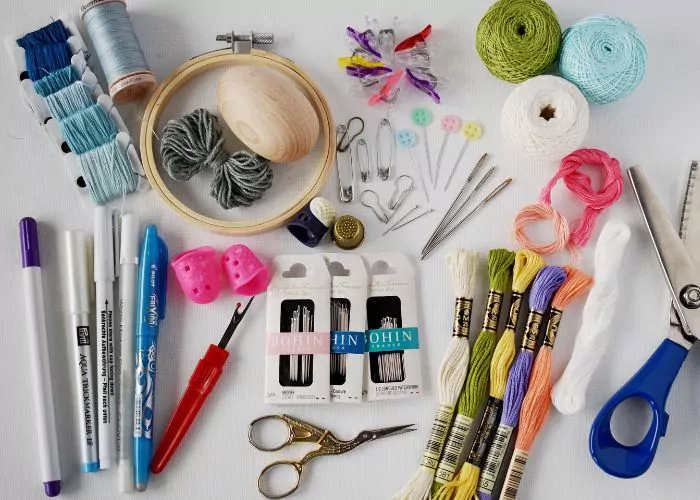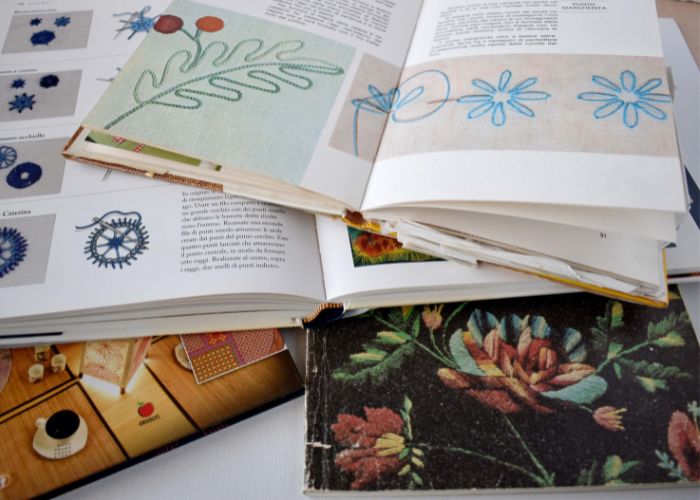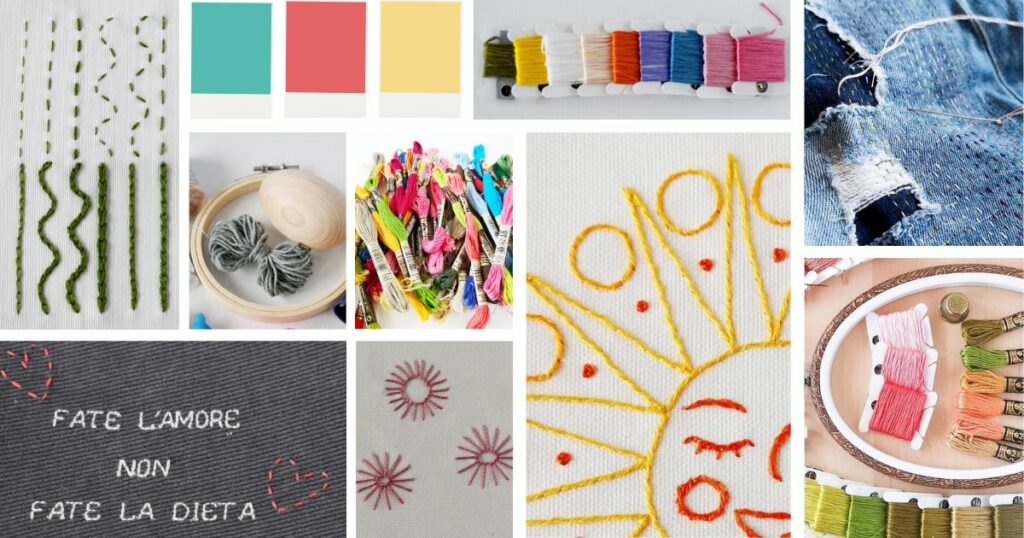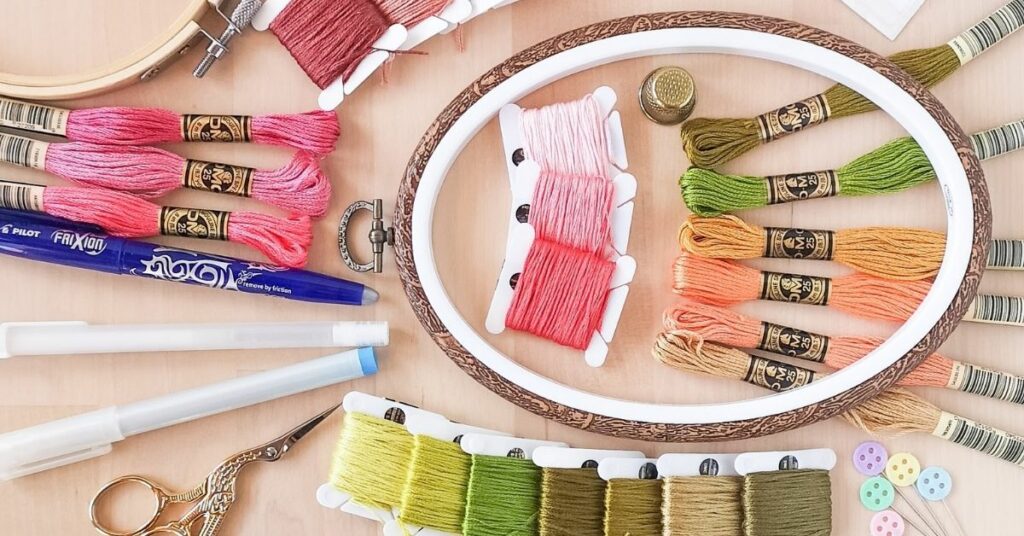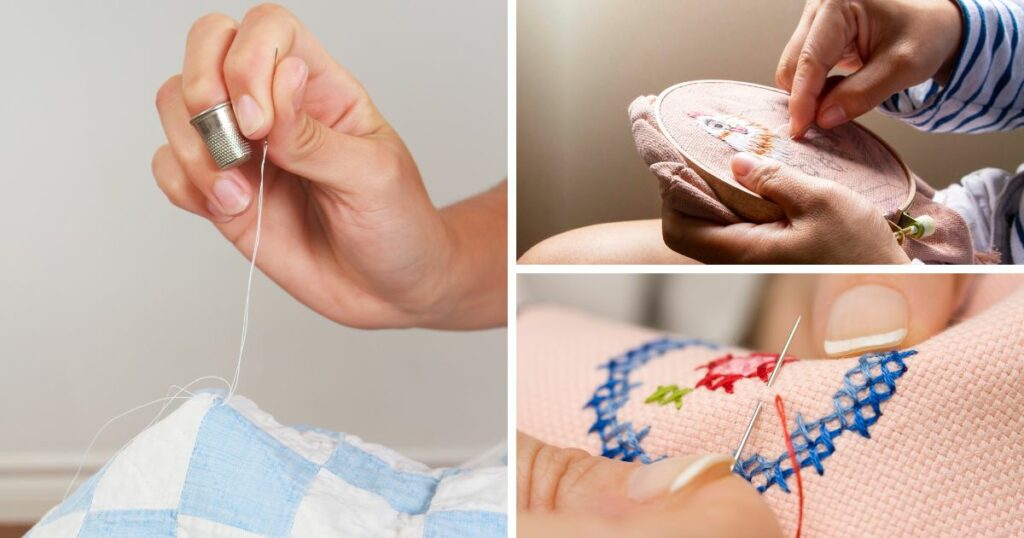Embroidery Resource Guide: Suppliers, Communities, and Online Platforms
Hand embroidery is not only an ancient textile craft or a hobby for old ladies. With the right resources at hand and a positive approach, hand embroidery can become a very practical skill and a grounding meditation, too. In today’s digital age, there are countless ways to learn, connect, and find inspiration. However, with numerous options available – including suppliers, online tutorials, social media communities, and niche marketplaces – it can be overwhelming to know where to begin. Therefore, I wrote this embroidery resource guide —a one-stop reference for everything you need, from the best places to buy supplies to the most engaging online communities.
Essential hand embroidery supplies
Whether you’re a beginner or an experienced stitcher, having the right materials is essential to any embroidery project. This section covers everything you need, from fabrics and threads to needles, hoops, and handy tools, along with recommendations on where to purchase them.
Fabric for hand embroidery
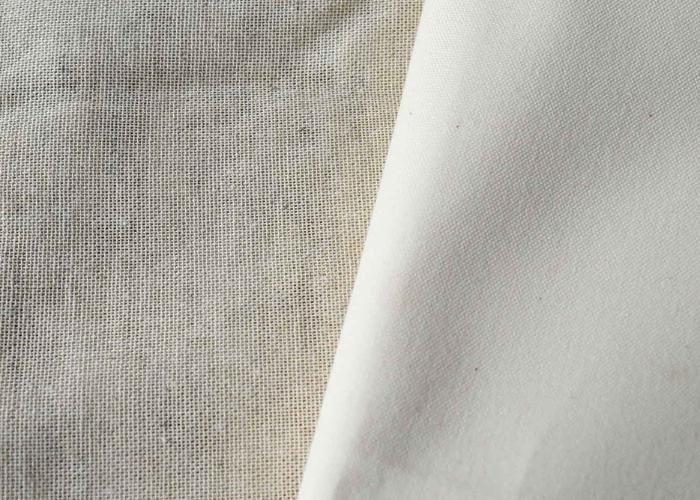
There is no such thing as the perfect fabric for every embroidery project, as the fabric choice highly depends on the project you plan to stitch and your personal needs and preferences. The fabric color, weaving type, and weight will highly depend on the project you plan to stitch.
In any case, certain rules apply to all projects. The general recommendation for embroidery fabrics is a medium-weight natural fabric with a tight weave (high thread count). It will do well for any surface embroidery project.
If you can afford it and need a high-quality fabric for an important embroidery project – go to a specialized craft store and choose the best quality linen or silk embroidery fabric. Go for cheaper alternatives for other stitching practices, learning to stitch, or testing. Hand embroidery doesn’t have to be an expensive hobby. You can often create an excellent embroidery project using basic embroidery fabrics.
You will find a more in-depth guide and ideas on where to source fabrics for hand embroidery in the article “An in-depth guide to hand embroidery fabrics. Discover what is the best fabric for hand embroidery and why“.
Embroidery floss and threads
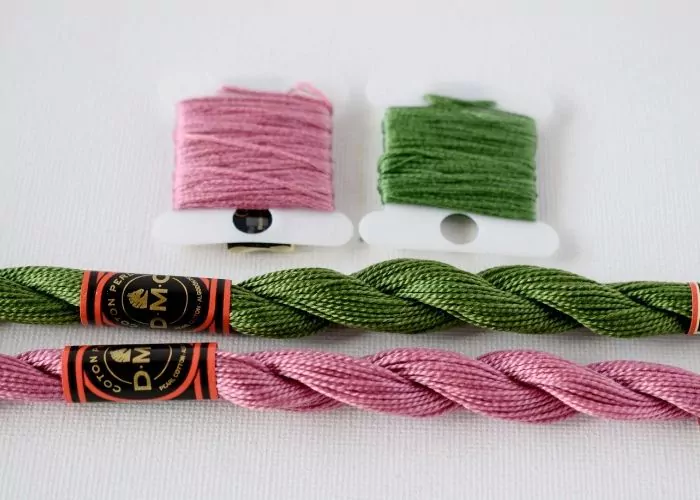
Another fundamental ingredient of great needlework is thread or floss. Please do not try to save on this essential supply. Buy only high-quality threads from tested suppliers, as poor-quality threads can not only ruin your stitching experience but also compromise the finished piece. What can be worse than hours spent stitching only to find out that the thread bleeds color all over the fabric?
Opt for natural threads and floss made by well-known producers like DMC, Anchor, Cosmo, or Madeira. They are tested, affordable, and accessible worldwide.
For more information on threads and floss, read these articles:
- Embroidery floss and threads. An in-depth guide to hand embroidery threads, floss, and other types of yarn you can use to embroider
- How to Organize Embroidery Floss and Thread: Practical Solutions for Busy Creatives
Embroidery needles
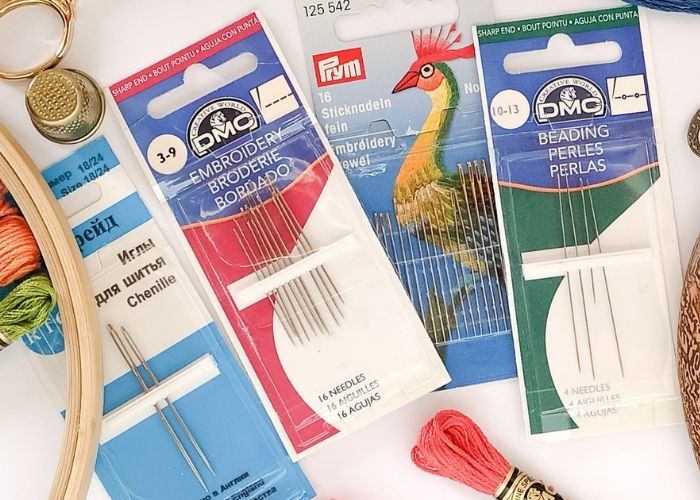
Another essential component of smooth stitching is a needle.
You probably already found out that not all the needles are the same. They vary in size and shape and are made for different purposes. Choosing the right needle will make your hand embroidery process more pleasant and easy.
The type of needle will depend on the stitching style you choose, such as cross-stitch, surface embroidery, or canvas work, as well as the type of fabric and thread you use.
If you opt for a crewel needle and embroidery floss, the size of the needle will depend on the number of floss strands you plan to use. For all 6 strands, I recommend using needle size 5. For 3-4 strands, use No. 7; for 2-3 strands, use No. 8; and for a single strand, use No. 9.
Read these articles to learn more about the needles:
- Hand embroidery needles and all you need to know to choose the right one
- How to organize embroidery needles: Needle organization tips and storage ideas
Hoops for hand embroidery
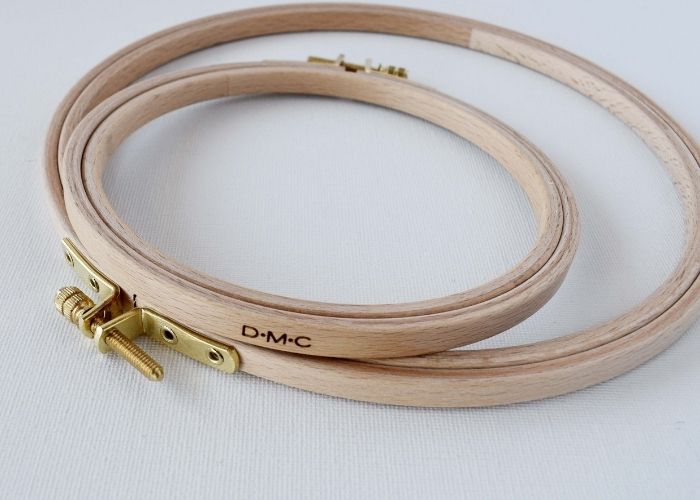
Do we really need to use one? Yes and no. It depends on the embroidery project you are planning. Some embroidery techniques, like sashiko or boro embroidery, do not require the use of an embroidery hoop. Other techniques, such as cross-stitch, can be worked with or without a hoop.
Modern surface embroidery, instead, requires the use of embroidery hoops. The hoop you use must be of good quality to ensure an even and consistent tension on the fabric while working on your project.
The medium-sized hoops, 15-18 cm (6-7 inches), are the most comfortable to stitch in. So, if you want to have one for stitching, opt for a high-quality, medium-sized wooden embroidery hoop.
More about the hoops:
- Embroidery hoops. Types, sizes, and how to choose the best hoop for hand embroidery
- Choosing the Perfect Embroidery Hoop Stand: Every Stitcher’s Must-Have
- Mini Embroidery Hoops: How to choose the best tiny hoop and how to use them
Embroidery accessories and other tools
Essentially, all you need to start stitching is hand embroidery fabric, thread, and a needle. On the other hand, accessories such as hoops, scissors, tracing tools, and needlebooks can make your needlework experience more pleasant, enjoyable, and straightforward.
For a beginner, I recommend getting these accessories:
- Embroidery scissors. Small and sharp to cut the threads and unpick the stitches when needed.
- Friction pen or water-soluble pen for pattern transfer.
- Needlebook or pincushion to organize your needles.
- Water soluble stabilizer or transfer paper for pattern transfer on dark fabrics.
Read these articles to learn more about tools and accessories to consider:
- Scissors for hand embroidery
- Hand Embroidery Accessories Every Stitcher Will Love: Cute, Clever & Useful
- Mending tools and materials. What you need to get started with visible mending
- How to use Carbon paper to transfer embroidery patterns onto dark and light-colored fabrics
- The Ultimate Guide to Water-Soluble Stabilizers for Hand Embroidery
Where to buy hand embroidery supplies
Hand embroidery tools and materials are specialized goods sold in specialized shops. As in many cases nowadays, you can choose between physical stores and online shops.
I keep an updated list of my favorite tools and materials on the page “Hand Embroidery Supplies” on this blog, so you can check it out for specific products.
Local shops & craft stores
In-person shopping in local craft stores has its charm. You can touch the fabric, note the sheer of the thread, and ask all the questions you have about the products you are choosing. On the other hand, the choice of brands can be limited, and prices are sometimes slightly higher than those online.
If you can, choose to support small businesses by checking local needlework shops. I often prefer to buy embroidery fabric from my local shops, as I like to touch it before making a purchase. Additionally, shopping local will save you on shipping fees, which can be high if you only need one skein of floss.
Chains like Michaels and Hobby Lobby carry basic supplies but do not expect to find the highest quality or specialized goods there.
Online retailers
Big and small online shops offer various range of embroidery supplies. Some are international retailers, such as Amazon or Etsy. Other smaller sellers operate locally.
Here are some sellers that I tested and bought from:
- Snuggly Monkey. US-based supplier offering premium hand embroidery and Sashiko supplies from around the world. They also have a shop on Etsy if you prefer this platform.
- Million of Stitches – a Canada-based supplier – offers everything you need for cross-stitching and embroidery.
- DMC offers its products directly on its website and on its DMC Amazon shop. Compare which one is more convenient in terms of shipping fees and product range.
- La Maison du Canevas et de la Broderie (in French), or La Casa del Canovaccio e del Ricamo (in Italian), is a huge online seller in Europe. DMC embroidery floss, perle cotton, fabrics, hoops, and various accessories are available in their shop.
- 123 Stitch – a US-based supplier that ships internationally, offers a wide range of threads, floss, fabrics, and notions for hand embroidery.
Embroidery learning & inspiration
Hand embroidery is a journey, not a destination. We all get started with a first stitch and learn new skills and techniques with every new project.
Hours of work are required to improve hand embroidery skills, but learning doesn’t have to be boring. Here are some ways to better your skills:
- Learn with video tutorials. If you are a visual learner, video tutorials can help you understand new embroidery techniques more quickly. Many authors offer video guides with their patterns. Also, you can learn new embroidery stitches or techniques by watching video tutorials on YouTube. For example, you will find 225 video tutorials on my YouTube channel.
- Online courses & workshops. Platforms like Skillshare, Domestika, or Craftsy offer various embroidery courses on a subscription or pay-per-course basis. You’ll also find a couple of free embroidery courses for beginners on my website.
- Blogs & websites. Embroidery blogs, such as mine – Practical Embroidery, offer various DIY tutorials and guides to help you learn new techniques and stitches. Check out also The Spruce Crafts, Sublime Stitching, or Needle’ n Thread for more embroidery education.
- Magazines. Online and physical magazines dedicated to hand embroidery are a great source of inspiration and an excellent learning medium. Check out Inspirations magazine, Embroidery magazine, or Love Embroidery magazine.
- Books & E-books. Libraries and bookstores offer a wide range of classic and modern embroidery books, catering to both beginners and advanced stitchers.
More embroidery learning and inspiration resources in these articles:
- How to Improve Your Hand Embroidery Skills: Tips and Exercises
- Hand Embroidery Inspiration: Where to Find and How to Keep It
- Visible Mending Ideas, Techniques, and Inspiration to Transform Your Clothes
- Best hand embroidery books: For reference, inspiration and skill-building
Hand embroidery communities & social media
Embroidery can be a pretty lonely activity. It is more fun when shared with others! Whether you’re looking for inspiration, troubleshooting advice, or just a place to show off your latest project, there’s a vibrant community waiting for you—both online and offline.
Facebook groups & forums
Facebook hosts some of the most active embroidery communities, where stitchers of all skill levels share tips, ask for advice, and showcase their work.
Check out these groups:
- Hand Embroidery Group – A supportive space for new and experienced embroiderers.
- Modern Hand Embroidery – Focused on contemporary designs and techniques.
Note. Always check group rules before posting—some are strictly no self-promotion, while others encourage sharing shops and tutorials.
Reddit communities
Reddit communities are dynamic spaces for casual and informative discussions. You can join the groups based on your location, favorite movie, or craft activity. Here are some stitching-related communities to explore:
- r/Embroidery – the largest subreddit for all things embroidery (WIPs, FO posts, and troubleshooting).
- r/Hand_Embroidery – A place to share hand embroidery pieces, resources, patterns, and more.
- r/Stitchy – all things stitching, sewing, embroidery, punch needle.
Hand embroidery is a visual art. Therefore, you will find many textile artists on this social media platform.
Follow these hashtags to discover stunning work:
- #HandEmbroidery – General embroidery inspiration.
- #SlowStitch – Mindful, meditative stitching.
- #ThreadPainting – Hyper-realistic embroidery.
- #modernembroidery – Contemporary embroidery artworks.
Accounts to follow for inspiration:
- @ceciledavidovici – original contemporary embroidery art
- @paulina.bart – if you like stitching and birds, this is an account to follow
- @emillieferris – get inspired by nature-fueled magical stitching
- @artyouhungry – follow her for colorful and bold portraits
- @soymigadepan – contemporary raised embroidery inspiration
- @elisabettaricami – follow her for classical thread painting and monogramming inspo
- @gimenaromero – original, inspiring, mixed media and stitching artist
- @dmc_embroidery – they share the works of various textile artists on their Instagram account
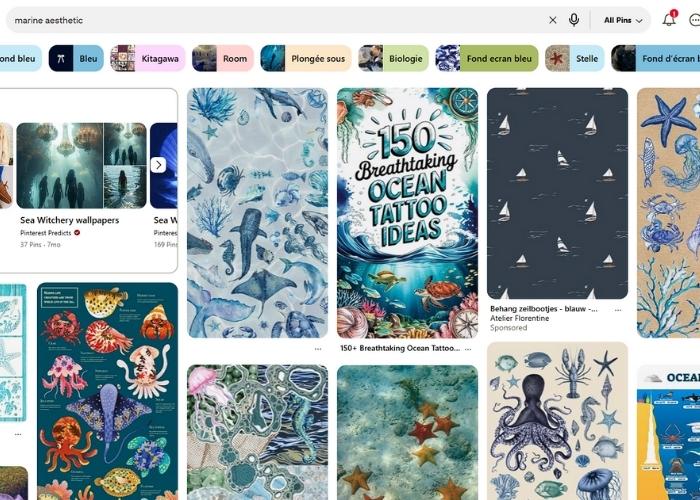
Pinterest is a visual search engine that will serve as an inspiration source for any artistic endeavor. I like to search for creative ideas with themed search terms that are not embroidery-related. For example, suppose I want to create an original sea-inspired embroidery design. In that case, I will look for the terms like “marine aesthetic” or “ocean inspiration.” On the other hand, if I want to find a hand embroidery pattern or tutorial, I will search for “sea embroidery ideas” instead.
For general hand embroidery inspiration, try searching terms like “embroidery patterns,” “embroidery designs,” or “embroidery inspiration.” And don’t forget to pin the ideas you like to your boards for easy reference later!
Local meetups & guilds
If you prefer in-person connections, look for local embroidery circles:
- Meetup – search for “embroidery” or “fiber arts” groups in your area.
- Local Libraries & Craft Stores – many host stitching circles.
- Embroiderers’ Guild of America – a US-based national organization with local chapters offering workshops and events.
Don’t see a group near you? Start your own! A casual café meetup can grow into a thriving stitching community.
Over to you
Embroidery is more than just a craft – it’s a creative journey, a meditative medium, a sustainability practice, an anti-consumerism statement, a protest against fast fashion, and a way to connect with a global community of stitchers. Whether you’re just starting or looking to refine your skills, having the right resources makes all the difference.
With this embroidery resource guide, you’re equipped to:
- Source quality materials without overspending.
- Learn and grow through online courses, tutorials, books, and magazines.
- Share your work and connect with fellow embroidery lovers.
Did I miss your favorite supplier or community? Share it in the comments to help fellow stitchers!
